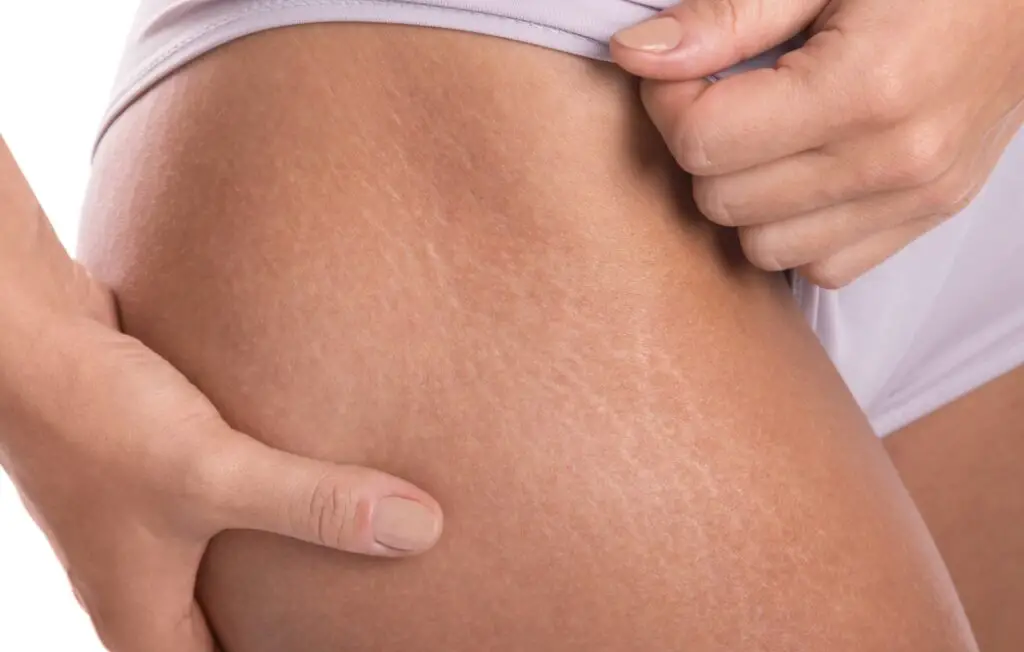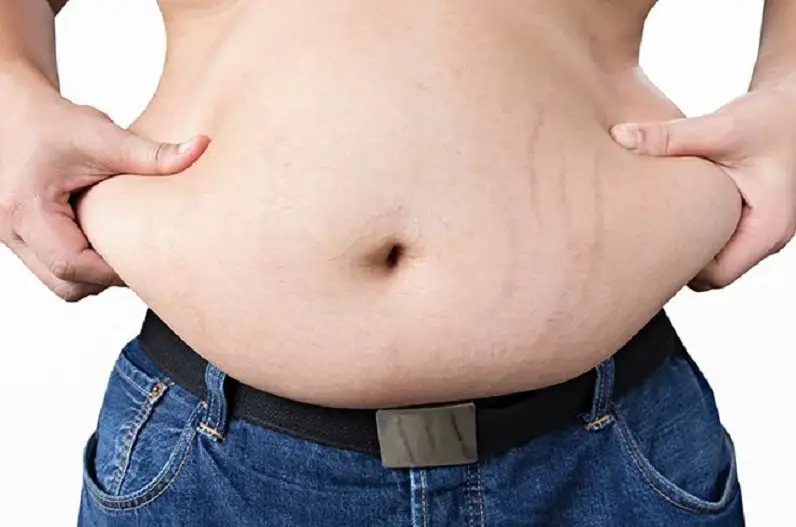Introduction
Does White Stretch Marks Mean Weight Loss: White stretch marks, also known as striae albae, are a type of scarring that typically appears as off-white or silvery streaks on the skin’s surface. They commonly occur when the skin undergoes rapid stretching or changes in shape, which can be associated with weight fluctuations, pregnancy, puberty, or muscle growth. However, the coloration of stretch marks varies depending on several factors, including skin tone, genetics, and the individual’s skin type.
While many people associate stretch marks with weight gain or pregnancy, it’s important to note that white stretch marks do not exclusively indicate weight loss or gain. In fact, they can persist even after weight loss, as they are a result of the skin’s dermal layer being stretched beyond its natural elasticity and developing scar tissue.
Weight loss can sometimes lead to a reduction in the overall size of the body, which may make existing stretch marks less noticeable due to skin tightening. However, the color of these marks may remain largely unchanged. Understanding the complex nature of white stretch marks is essential for dispelling misconceptions and helping individuals make informed decisions about their skin health and body transformations. In the following sections, we will explore the various factors that contribute to the formation of white stretch marks and provide insights into managing and preventing them.

Do stretch marks turn white when you lose weight?
Permitting that rapid weight gain stops and prevents your skin from stretching more, you’ll notice your marks will fade from deep red or purple to a silvery or white color. With time, they may also become smoother and less deep in appearance. This fading process can take as little as several months to several years.
Weight Loss and Stretch Marks
Skin Type: Individual differences in skin type and genetics play a significant role in how stretch marks respond to weight loss. Some people’s stretch marks may fade and turn white more quickly than others.
Age of the Stretch Marks: Newer stretch marks are often more red or purple, while older ones tend to be lighter in color. Weight loss can contribute to the fading of newer stretch marks, making them appear white sooner.
Collagen Production: Collagen is a protein that helps maintain skin’s elasticity. Weight loss can stimulate collagen production, which may help improve the appearance of stretch marks.
Hydration: Proper skin hydration can also impact the appearance of stretch marks. Keeping the skin well-moisturized can help reduce the prominence of stretch marks.
Treatment Options: Various treatments are available to help fade and reduce the appearance of stretch marks, including topical creams, laser therapy, and microdermabrasion. These treatments can be effective in speeding up the process of turning stretch marks white.
Can stretch marks appear when losing weight?
Conclusion. Stretch marks can become visible when you are losing weight and are quite common as the skin stretches due to weight gain or rapid growth. While they may look unattractive, fortunately, they do not indicate any serious medical problems.
Stretch Marks and Weight Loss
Weight Loss Timing: When you lose weight rapidly, the skin may not have enough time to adapt to the changes in body size. The sudden reduction in body mass can lead to the formation of stretch marks, especially if the weight loss is significant.
Skin Elasticity: Just as rapid weight gain can stretch the skin and cause stretch marks, so can rapid weight loss. The skin may not contract as quickly as the fat beneath it disappears, leading to the appearance of stretch marks.
Pre-existing Stretch Marks: Some individuals may already have stretch marks that are not visible due to excess weight. As they lose weight, these existing stretch marks may become more noticeable.
Factors Beyond Weight: Weight loss is not the sole cause of stretch marks. Other factors, such as muscle gain, changes in body composition, and hormonal fluctuations, can also contribute to the development of stretch marks during the weight loss process.
Prevention and Management
Gradual Weight Loss: Aim for a slow and steady weight loss rather than rapid, drastic changes. This allows your skin to adapt more effectively to the changes in body size.
Hydration: Keep your skin well-hydrated by drinking plenty of water and using moisturizers. Well-moisturized skin is more supple and less prone to stretch marks.
Topical Treatments: There are various creams and oils containing ingredients like vitamin E, hyaluronic acid, or retinoids that may help improve the appearance of stretch marks over time.
Is it good if my stretch marks are white?
These are the easiest to treat, as the reddish colour indicates that blood vessels are still present in the tissue. When they change to white, it means that the tissue has already healed and treatment to remove stretch marks will be more difficult.
The Evolution of Stretch Marks
Red or Purple: Initially, stretch marks are often red or purple due to blood vessels showing through the damaged skin. At this stage, they are considered “fresh” or “new.”
Pink or Light Brown: As the stretch marks mature, they may lighten to a pink or light brown color. This indicates that the healing process is underway.
White or Silver: Eventually, stretch marks may turn white or silver. This is a sign that the skin has undergone significant healing, and the blood vessels are no longer visible through the affected area.
Is It Good if Stretch Marks Are White
Visibility: White stretch marks are less noticeable than their red or purple counterparts. For many people, this reduced visibility can be seen as a positive change, especially if they were self-conscious about the appearance of their stretch marks.
Maturity: White stretch marks are often considered more mature and less likely to worsen over time. While they may not completely disappear, they are less likely to undergo further significant changes.
Healing: The transition to white or silver color signifies that the skin has healed to some extent. This can be a reassuring sign for individuals who have been actively managing their stretch marks.
Why are my stretch marks turning white?
Once the marks turn white, however, it suggests that the blood vessels have narrowed. Narrow blood vessels make successful treatment less likely. Nonetheless, it may be possible to reduce the appearance of some white stretch marks using cosmetic treatments or home remedies.
The Evolution of Stretch Marks
Red or Purple: When stretch marks first appear, they are often red or purple in color. This is due to the initial damage to the skin’s collagen and blood vessels beneath the surface. At this stage, the stretch marks are considered “fresh.”
Pink or Light Brown: As time passes and the healing process begins, stretch marks may transition to a pink or light brown color. This is a sign that the skin is in the process of repairing itself.
White or Silver: Eventually, stretch marks may turn white or silver. This color change signifies that the healing process has progressed significantly, and the blood vessels are no longer visible through the affected area.
Reasons for White Stretch Marks
Scar Tissue Formation: The primary reason stretch marks turn white is the formation of scar tissue. As the skin heals from the initial damage, collagen production increases in the affected area. Collagen is a fibrous protein responsible for the skin’s structure and elasticity. The accumulation of collagen in the healing stretch marks can make them appear lighter in color.
Blood Vessel Changes: The initial red or purple color of stretch marks is due to visible blood vessels beneath the damaged skin. Over time, these blood vessels naturally recede, making the stretch marks less visibly red or purple and contributing to their whitening.
Skin Maturation: Stretch marks become more “mature” as they turn white. Mature stretch marks are less likely to undergo significant changes in appearance, making them more stable and less noticeable.
How long stretch marks turn white?
Stretch marks usually lose their color in six to twelve months, changing from red to white. Stretch marks should be treated as soon as they appear, when laser procedures are much more effective. Red stretch marks are easier to remove with laser treatments than old scars or stretch marks that have already turned white.
Factors Influencing the Transition to White Stretch Marks
Skin Type: Individual skin types and genetics play a significant role in how stretch marks develop and change color. Some people may notice their stretch marks turning white relatively quickly, while others may take longer.
Age of Stretch Marks: The age of the stretch marks is a crucial factor. Newer stretch marks are more likely to be red or purple, while older ones are more likely to have turned white or silver.
Treatment and Care: Proper skincare, including moisturizing and the use of topical treatments, can help speed up the healing process and the transition to white stretch marks.
Hydration: Keeping the skin well-hydrated can aid in the healing process. Hydrated skin is generally more supple and responsive to the repair of damaged tissue.
Weight and Muscle Changes: If the stretch marks are the result of significant weight loss or muscle gain, the timeline for their color change may be influenced by the body’s ability to adapt to these changes.
How long does white stretch marks last?
How long do stretch marks take to fade? In general, stretch marks take between six and 12 months to fade. With treatment, they often fade faster.
Factors Influencing the Duration of White Stretch Marks
Age of the Stretch Marks: The age of the stretch marks plays a significant role in how long they last. Older white stretch marks are more likely to remain unchanged, while newer ones may continue to evolve.
Skin Type and Genetics: Individual differences in skin type and genetics can affect how stretch marks develop and persist. Some individuals may have skin that is more prone to retaining white stretch marks.
Treatment and Skincare: The use of topical treatments, moisturizers, and professional treatments can influence the longevity of white stretch marks. Regular care and maintenance can help improve their appearance.
Overall Health: General health and well-being can impact the body’s ability to heal and repair the skin. Leading a healthy lifestyle can contribute to the overall health of your skin.
Hormonal Changes: Hormonal fluctuations, such as those experienced during pregnancy, puberty, or menopause, can affect the appearance and persistence of white stretch marks.
Weight and Muscle Changes: If the white stretch marks resulted from significant weight loss or muscle gain, the duration of their visibility may be influenced by the body’s ability to adapt to these changes.
What removes white stretch marks?
Microdermabrasion is a painless procedure to reduce the appearance of white stretch marks. This procedure targets the upper layer of skin, and works by stimulating the skin to tighten collagen and elastin fibers.
Methods for Removing White Stretch Marks
Topical Treatments
Retinoid Creams: Retinoids, such as tretinoin, are derived from vitamin A and are known to stimulate collagen production and promote skin renewal. Over time, retinoid creams may help improve the texture and appearance of white stretch marks.
Hyaluronic Acid: Hyaluronic acid is a natural substance found in the skin that helps maintain hydration and skin elasticity. Topical creams or serums containing hyaluronic acid can be used to moisturize and plump the skin, potentially reducing the visibility of stretch marks.
Vitamin E: Vitamin E is known for its antioxidant properties and ability to nourish the skin. Applying vitamin E oil or creams may help with skin hydration and healing.
Laser Therapy
Fractional Laser Therapy: Fractional laser treatments use laser beams to target the affected skin area, stimulating collagen production and promoting skin regeneration. This can lead to a reduction in the appearance of white stretch marks.
Pulsed Dye Laser: Pulsed dye laser therapy is particularly effective in treating red or purple stretch marks but can also be used to improve the appearance of white stretch marks by targeting the damaged blood vessels.
Microdermabrasion
Microdermabrasion is a non-invasive procedure that exfoliates the top layer of skin using tiny crystals. This can help improve the texture of white stretch marks and promote the growth of new, healthier skin.
Chemical Peels
Chemical peels involve applying a chemical solution to the skin to remove the top layer. This process encourages the growth of new skin cells and can reduce the visibility of stretch marks.
Why do I have white stretch marks on my thighs?
Over time, your blood vessels will narrow and cause your stretch marks to change color. Marks that were once red may turn skin-colored, silver or white.
Rapid Growth during Adolescence: One of the primary reasons for the development of white stretch marks on the thighs is rapid growth during adolescence. During puberty, adolescents often experience significant growth spurts, leading to the stretching of the skin. This stretching can cause the collagen and elastin fibers in the skin to tear, resulting in the formation of stretch marks. Over time, as these stretch marks heal, they may turn white or silver.
Weight Fluctuations: Rapid weight gain or loss can also lead to the appearance of white stretch marks on the thighs. When you gain weight quickly, the skin may not have enough time to adapt to the changes in body size, leading to stretch marks. Similarly, when you lose weight rapidly, the skin may not contract as quickly as the fat beneath it disappears, resulting in the development of stretch marks.
Pregnancy: Pregnancy is another common cause of white stretch marks on the thighs. As the baby grows and the abdomen expands, the skin on the thighs can also stretch, causing stretch marks to form. After childbirth, these stretch marks may gradually fade and turn white.
Hormonal Changes: Hormonal fluctuations, such as those that occur during pregnancy or due to medical conditions, can weaken the skin’s collagen and elastin fibers, making it more susceptible to stretching and the development of stretch marks.
Genetics: Genetics play a significant role in determining an individual’s susceptibility to stretch marks. If your parents or close relatives have a history of stretch marks, you may be more likely to develop them as well.

Conclusion
The presence of white stretch marks does not necessarily indicate weight loss as the sole cause. While these silvery streaks can indeed be associated with changes in body shape and fluctuations in weight, they are primarily a result of the skin’s stretching and scarring process. White stretch marks can persist even after weight loss, serving as a reminder of the body’s remarkable adaptability. Understanding that stretch marks are influenced by a range of factors, including genetics, skin type, and hormonal changes, is crucial in dispelling misconceptions about their significance. Instead of fixating on the color of stretch marks, it is more important to focus on maintaining healthy skin and a balanced approach to weight management. Embracing one’s body and skin, regardless of stretch marks, is a step towards greater self-acceptance and overall well-being.
The severity and age of the stretch marks can also affect their appearance. Older, more established white stretch marks may be less noticeable than newer ones, regardless of the cause. Skin Care and Hydration: Proper skin care and hydration can help improve the appearance of stretch marks. Regular moisturization and the use of specialized creams or oils can make stretch marks appear less prominent.
In summary, while weight loss can lead to changes in the body and may impact the visibility of stretch marks, the presence of white stretch marks is not an exclusive indicator of weight loss. Understanding that stretch marks are influenced by a combination of genetic, skin-related, hormonal, and lifestyle factors can help individuals better manage and care for their skin. Embracing a holistic approach to skin health, including proper hydration and skincare, can be beneficial for anyone, regardless of their body’s natural changes over time.

